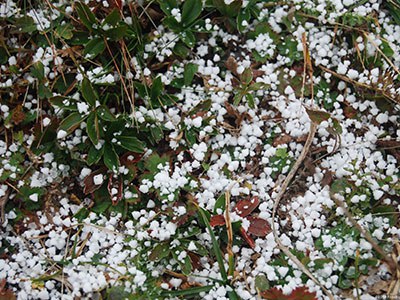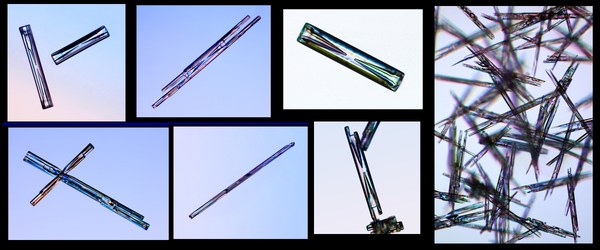For nearly 50 years, W.A. Bentley painstakingly photographed snowflakes at his workshop in Vermont. A difficult task considering how quickly a snowflake can disappear on a glove or even on bare ground. His images reveal the intricate detail that nature creates in the symmetry of each crystal, and seem to provide evidence that no two snowflakes are alike.
We revel in the beauty of snowflakes each time they float quietly to the ground from billowing grey clouds above. Perhaps the most recognizable and enchanting of all snowflakes is the stellar snow crystal. Even its name alludes to its beauty.
 Stellar snowflakes begin as simple hexagons, with six sides. Their unique, complex, and seemingly symmetrical shapes begin to build as they tumble their way through a cloud. As the crystal grows, branches or arms form from each corner. The shape of each arm is determined by changes in temperatures and humidity. As the crystal tumbles through the cloud, the arms continue to grow. The symmetry we see is produced because all six arms of the crystal form under the same conditions at the same time.
Stellar snowflakes begin as simple hexagons, with six sides. Their unique, complex, and seemingly symmetrical shapes begin to build as they tumble their way through a cloud. As the crystal grows, branches or arms form from each corner. The shape of each arm is determined by changes in temperatures and humidity. As the crystal tumbles through the cloud, the arms continue to grow. The symmetry we see is produced because all six arms of the crystal form under the same conditions at the same time.
 Although stellar snowflakes have the most symmetry, a great name, and are the most sought after for photographers, most snowflakes are irregular and lack symmetry. Graupel for instance, can often be mistaken for hail, but has a softer and more crumbly texture. Graupel forms when liquid droplets in clouds freeze and crystallize to form a lumpy pellet. If you have ever seen the Styrofoam filling for a beanbag chair, you’ve got a good idea of what graupel looks like! Although not as beautiful to look at as stellar snow crystals, graupel still has a cool name.
Although stellar snowflakes have the most symmetry, a great name, and are the most sought after for photographers, most snowflakes are irregular and lack symmetry. Graupel for instance, can often be mistaken for hail, but has a softer and more crumbly texture. Graupel forms when liquid droplets in clouds freeze and crystallize to form a lumpy pellet. If you have ever seen the Styrofoam filling for a beanbag chair, you’ve got a good idea of what graupel looks like! Although not as beautiful to look at as stellar snow crystals, graupel still has a cool name.
 Have you ever felt like pins and needles are hitting your face when you step outside during a snowstorm or while you were on a chairlift? You may have encountered columnar or needle snow crystals. These little bits of snow are small and slender and often look like small hairs when they land on your gloves or hat. Add to that a stiff wind and you might feel like you are getting peppered with pins and needles!
Have you ever felt like pins and needles are hitting your face when you step outside during a snowstorm or while you were on a chairlift? You may have encountered columnar or needle snow crystals. These little bits of snow are small and slender and often look like small hairs when they land on your gloves or hat. Add to that a stiff wind and you might feel like you are getting peppered with pins and needles!
If you need a little more convincing to get you out the door and into the cold to examine snowflakes, maybe some of these techniques will inspire you to get out there and explore them in more detail:
1. A great way to get up close and personal with snowflakes is to catch them, but without a few tools you won’t have enough time to really see the details. One way to take a closer look is to use black construction paper and a magnifying glass. Make sure the paper is cold, and then a catch a few snowflakes to examine!
2. Preserving snowflakes is also a possibility, but can be a bit tricky. If you have microscope slides (or something similar), toothpicks, and aerosol hairspray give this a try: Place the slides in the freezer to get them good and cold. Also, make sure the hairspray has been chilled outside or in an unheated garage. When the snow begins falling, bring the slides outside and spray one side of a slide with the hairspray. Catch a snowflake on the sticky side of the slide and use the toothpick to move it around if you wish. Then, place the slide with the snowflake in a cold area to dry and where no other snowflakes will fall on it. The snowflake will disappear as the hairspray dries, but will leave an imprint that you can marvel at with the naked eye or under a microscope.
3. Let’s be honest, the most fun way to really enjoy snowflakes is trying to catch them on your tongue!
It is pretty amazing that such small crystals can accumulate and provide enough water to meet our needs throughout the year in Central Oregon. The snow gods and goddesses have been good to us this year, so get out there and enjoy it before spring melts it all away!
Resources:
National Snow and Ice Data Center: https://nsidc.org/cryosphere/snow/index.html
Kenneth Libbrecht: http://www.snowcrystals.com/


